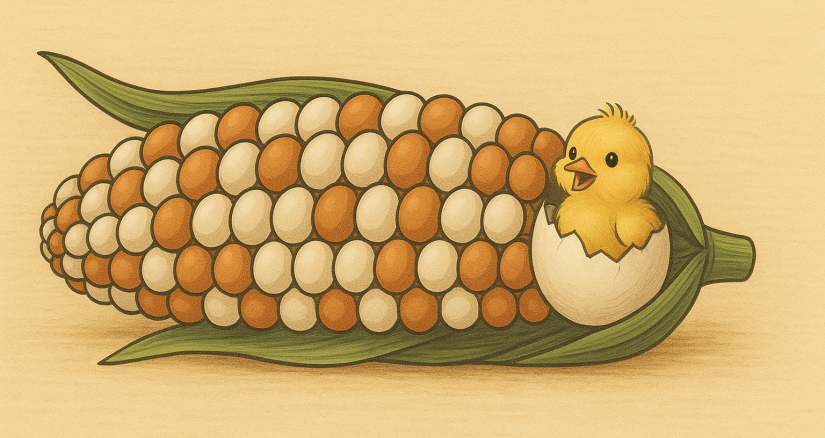
Eggcorns in the Pet Food Aisle: How Marketing Misinterpretations Lead Pet Owners Astray
As a self-proclaimed grammar nerd, one of my favorite pastimes is helping people with their writing. And for any editor, clarity in communication is of the utmost importance. However, the English language doesn’t always make it easy for us.
If you’ve ever played a game of “telephone,” you’ll understand what I mean. Sometimes, the words we use to describe our lives, our work, and the situations we face are used so broadly and widely that they become twisted or changed throughout the course of communication, eventually taking on lives of their own.
This is best illustrated by the eggcorn, a linguistic phenomenon where a word or phrase is mistakenly replaced with one that sounds similar and may make conceptual sense but is technically and grammatically incorrect. The term "eggcorn" itself is an example of this phenomenon—the term was coined by Geoff Pullum, a British-American linguist, in 2003. Pullum came up with the term after observing that someone had described an “acorn” as an “egg corn,” and later the term eggcorn was born to describe all such linguistic incidents.
You’ve likely heard or read variations of other eggcorns in your day-to-day life. Some of the most common include:
- “That’s a mute point,” instead of the correct term, moot point.
- “For all intensive purposes…” when it should really be for all intents and purposes.
- “He was told to tow the line,” rather than toe the line.
- “Before it gets too out of hand, let’s nip it in the butt,” instead of the correct term, nip it in the bud.
- “This might peak your interest,” when it should really be pique your interest.
- “It’s a doggie dog world,” instead of dog-eat-dog world.
Many pet food myths function similarly—they contain enough truth to sound reasonable and spread widely, but they may be fundamentally flawed, lack scientific evidence to back them up, not tell the whole truth, or miss the point entirely.
Let’s explore two eggcorns that exist in the pet food industry and why they deserve a more critical look.

Photo by seventyfourimages
Byproducts and Upcycled Foods Are Just Waste
Byproducts get a bad rap, but they don’t always deserve it. Many pet food formulas utilize whole and rendered byproducts from animal production to ensure no part of an animal goes to waste. However, there have been countless marketing campaigns in recent years touting rendered byproducts in pet food as less nutritious or less appetizing, ultimately branding them as “waste.”
The rising upcycling movement could face a similar misunderstanding. Upcycled ingredients for use in both human and pet food products are typically recovered from grocery stores, restaurant surplus, and other commercial sources of food. Globally, food waste is a massive problem—1.3 billion tons of food is wasted each year, enough to feed nearly half of the world's population for a day.
The eggcorn has a kernel of truth—these ingredients would be waste if we didn’t incorporate them into pet food. However, “waste” implies that rendered meats, byproducts, and upcycled ingredients are of lower quality and nutritionally empty. This is simply not the case.
Without utilizing the rendering process or byproducts, all the parts of animals that we aren’t inclined to serve at a Western dinner table would go to waste, literally and figuratively. The nutritional value of those ingredients is wasted, the precious resources used to raise that animal are wasted, and the ingredients themselves are sent away to rot in a landfill. And without upcycled ingredients, we continue to feed a monumental global food waste problem with significant economic and environmental consequences.
To combat this pet food eggcorn, I suggest we redefine the way we think about “waste.” Instead of judging byproducts and upcycled ingredients through the lens of our own food preferences, we should judge them based on their nutritional value and ability to contribute to more sustainable food systems. What constitutes “waste” to human palates can be incredibly valuable from a resource perspective and nutritionally dense for pets, and by debunking this common pet food myth, we can transform otherwise wasted materials into purposeful nutrition that supports environmental stewardship at the same time.
Want to dig deeper? Check out our recent episode of the Barking Mad podcast about upcycled ingredients in pet nutrition!
Home-Cooked Meals Are Healthier Than Commercial Diets
This eggcorn taps into pet owners' deepest desires to provide the best for their companions. The appeal is undeniable: fresh ingredients, loving preparation, and complete control over what goes into your pet's bowl. Simple in theory, yet much more complicated in practice.
Home-cooked pet food is seen by some as inherently superior to commercial pet food, but in reality, it can open the door for nutrient deficiencies, gut microbiome imbalances, and general health issues that do more harm than good for the pet. A review of several studies that looked at home-cooked diets for dogs and cats concluded that most homemade meals are deficient in key vitamins, minerals, and even amino acids.
This is because of another unintended phenomenon called “diet drift,” in which a diet is slowly (and often unintentionally) modified over time, making it unbalanced from meal to meal. Additionally, many pet parents find homemade pet food recipes online or develop their pets’ meal plans with someone who isn’t qualified in how to properly balance nutrients. Working with expert animal nutritionists is really the only way to ensure a homemade pet food is complete and balanced.
The Association of American Feed Control Officials (AAFCO) sets recommended minimum nutrient requirements for dogs and cats at various life stages. These nutrient requirements should be followed by any compliant commercial pet food manufacturer and set to keep pets healthy and thriving, but when they aren’t consistently met, they can pose dangerous health risks to a pet.
In short, homemade diets are only as good as their formulation. Without careful nutrient analysis and professional guidance, they risk being incomplete, imbalanced, and biologically harmful over time.
The eggcorn here is that emotional satisfaction and good intentions will always equal nutritional superiority, when the reality is that effective pet nutrition demands the same scientific rigor and precision as commercial formulation—regardless of where it's prepared.

Photo by foodphotoalex
Correcting the Record
Setting eggcorns straight doesn’t mean dismissing the underlying sentiments entirely. Instead, it involves acknowledging the kernel of truth while also considering the bigger, more nuanced picture.
Pet food companies can use this framework to develop clearer marketing and label claims that anticipate and address common misconceptions (rather than claims that feed into them). Instead of hiding byproducts, explain their nutritional value. Transform potential concerns into selling points by leading with education rather than evasion, anticipating consumer questions and answering them preemptively to build trust and prevent information vacuums where eggcorns flourish.
Effective education goes a long way. Brands that provide more transparency in their ingredient sourcing, formulation, and manufacturing operations can stop pet food eggcorns in their tracks by de-sensationalizing misconceptions and demystifying complex nutritional concepts.
Further, pet industry retailers have a role to play in battling common pet food myths. With the proper training and education, retail partners can talk customers through some of these nutritional eggcorns and help pet parents make the best purchase for their pet, even despite preconceived notions and assumptions.
The Whole Truth Approach
BSM Partners doesn’t deal in eggcorns—we’re interested in the whole truth and nothing but, even when it’s a little more complicated than a simplified half-truth. Industry professionals and pet owners alike can look to our team for trusted guidance and expert thought leadership when it comes to developing and marketing products that don’t feed into common misconceptions but overcome them. Keep up with our expert insights here on LinkedIn, at www.bsmpartners.net/insights, and through our podcast, Barking Mad.
Follow us on LinkedIn for the latest updates on all things happening here at BSM Partners.
About the Author
Jordan Tyler is the Director of Media at BSM Partners and co-host of the Barking Mad podcast. She has more than five years of experience reporting on trends, best practices and developments in the North American pet nutrition industry. Jordan resides in Bentonville, Arkansas, with her husband and their four furry family members.
This content is the property of BSM Partners. Reproduction or retransmission or repurposing of any portion of this content is expressly prohibited without the approval of BSM Partners and is governed by the terms and conditions explained here.